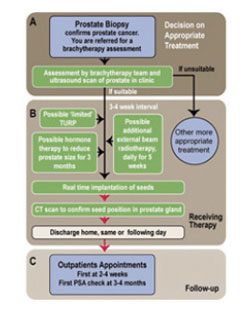
Tailoring Technology to Treatment
Is prostate brachytherapy right for you?
Deciding whether prostate brachytherapy is right for you
At The Prostate Brachytherapy Centre we understand that choosing a treatment for prostate
cancer is not an easy decision and we want to help you chose a treatment that is right for you.
We know that there is a lot to take in and we want you to fully understand what is involved and why, so do not be afraid to ask questions. We do not mind repeating what we have said if you did not understand it the first time. If you want to, you can bring someone with you or write notes, as this may help you remember what has been said.
The right treatment for you will depend on the stage of your cancer, your age, possible side effects of the treatment, whether your disease might potentially develop over time, and of course, your own personal preferences.
If you have localised prostate cancer (your cancer is contained within the prostate gland) and you are a suitable candidate for brachytherapy, it will still be your decision whether you want to have brachytherapy or not.
Click image to enlarge diagram
The Stage of Your Cancer
The stage of your cancer refers to how far your cancer has spread. The classification commonly used to stage prostate cancer in the UK is shown here in a simplified form. (The prefix T is used to identify the tumour stage, i.e.T1 or T2). It is very important to remember that although all prostate cancers have the potential to progress, it may take many years to pass from Stage 1 to 4.
- Stage 1
Earliest stage, where the cancer is so small that it cannot be felt on rectal examination, but is discovered in a prostate biopsy or in prostate tissue that has been surgically removed to ‘ unblock ’ the flow of urine (as in a transurethral resection of the prostate – TURP). - Stage 2
The tumour can now be felt on rectal examination, but is still confined to the prostate gland and has not spread. - Stage 3
The tumour has spread outside the gland and may have invaded the seminal vesicles. - Stage 4
The tumour has spread to involve surrounding tissues such as the rectum, bladder or muscles of the pelvis.
